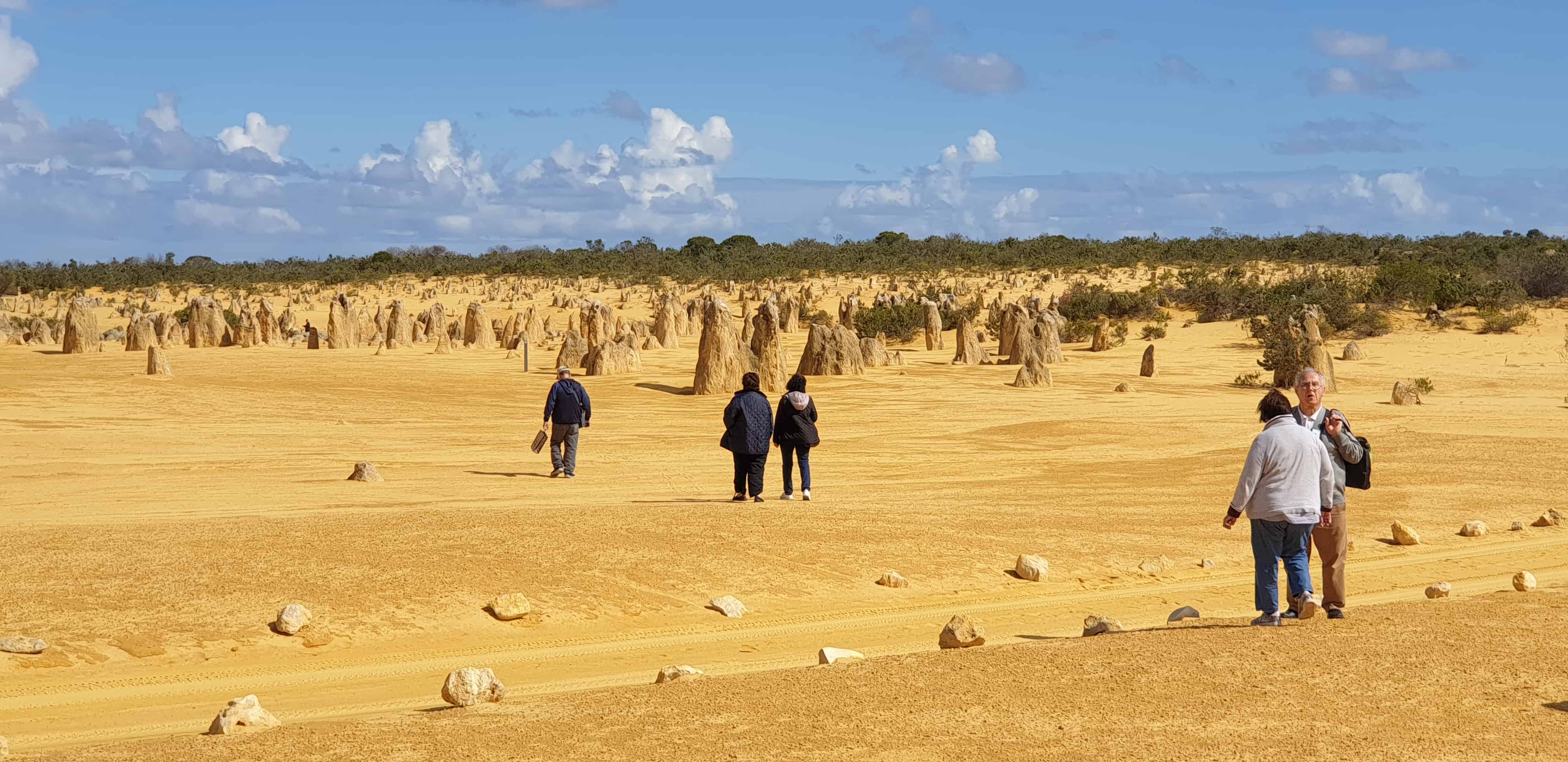
The discoveries in your own backyard especially along the Coral Coast of Western Australia has brought many surprises and greater appreciation by the forced travel within Western Australia in the last eighteen months. With border closures creating challenges for Western Australians to venture across states to explore, many have opted to travel within the state thus pumping millions of dollars in revenue into regional areas. We can also see this just by looking at the number of caravans that are on the roads and often driven by people who have never done so before! That, my friends is a discussion for another day.
Recently, I took a group of my senior clients on a 6 day 5 night tour along the Coral Coast hosted by a locally owned and operated family business, Casey Tours. This year they will be celebrating 45 years in the business having taken thousands of its clients in to some of the remotest parts of the country.
The tour coincided with the beginning of the wildflower season. As a non expert in all things wildflowers, I can assure you that this year will be a bumper one just by seeing what hasn’t bloomed yet. If you are considering in exploring the wildflowers, I highly recommend Casey Tours Wildflowers 4 day tours which includes a botanist guide. Going with a botanist guide, you will get a lot more enjoyment from your field trip other than saying, “oooh they are pretty fields of purple flowers”. To the uninitiated like myself, pretty purple flowers are the eyesore to a botanist and a livestock killer for farmers, an invasive weed more commonly called “Patterson’s Curse”. Supposedly named after the Patterson family in New South Wales who planted it in their garden in the 1880’s, it can cost upwards of $250 million per year for farmers through lost productivity in pastures, control costs and wool contamination.
Our first stop on our six day journey was at the iconic Pinnacles in the Nambung National Park. For many it was the first time visiting these limestone structures which were exposed when the sea receded some 25,000-30,000 years ago. A leisurely two hour drive north of Perth off the Indian Ocean Drive you get a glimpse of the colour contrasts of the landscape from the yellow desert and limestone outcrops, to the white sandy dunes to the beautiful blue hues of our Indian Ocean.
One of the many benefits of joining a guided tour even domestically is that you are taken to locations that you may not necessarily go to on your own. I found this was further reinforced on the number of stops we did on the following six days. Our next stop at the Lesueur National Park was one of them. With over 1100 species of flora identified, 10% of the state’s known flora is located right in this national park! It is also a great bird spotting haven for bird lovers with over 100 species within the park who rely on the flora for their survival. Some of the plants identified were the:
The 18.5km Lesueur Scenic Drive takes you close to the two mesas, Mount Lesueur and Mount Michaud. It is all sealed road making for an easy drive, even if you are towing a caravan. What is really interesting about the location of the road through the national park is that they purposely built it predominantly in the gulleys rather than up the hill. This is to prevent the spread of dieback, a disease that kills native plants, spread through the movement of infected soil and water.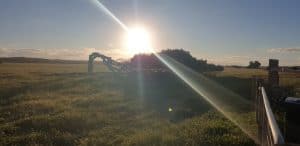
Leaving the coastal road at Leeman, we headed north for our final destination of the day in Geraldton. Enroute, you get to see the iconic leaning trees just north of the Greenough Historic Settlement. With the buffetting winds in the area often given as the cause of these red river gums growing horizontally, it is in fact a combination of wind strength and the salinity of the wind. It is believed that this started happening after the big flood of 1888 and the high magnesium levels in the soil together with the wind they started growing bent.
With bags loaded back onto the bus, we farewell Geraldton without having some explorations to be done first. One such stop is the moving memorial dedicated to the 645 sailors lives lost on the HMAS Sydney II off Steep Point in 1941. The previous night we had so much rain I can’t remember the last time hearing it come down so hard and for so long. Our early morning visit up at Mount Scott for our Memorial visit, we were greated with a stillness and freshness in the air that made our attendance even more moving.
I don’t have any personal connections to any of the sailors lost however, the story has always had me intrigued ever since I learnt about this event as a teenager living in Carnarvon. This was my second visit to the memorial and I still feel moved by the beautiful representations that are all around the site. From the 644 gulls engraved in the Pool of Remembrance whilst the 645th, a two metre stainless steel gull fixed on the wingtip on the map of the exact location where the wreck now lies. These gulls are also found and create the Dome of Souls, the birds also symbolising the spirits of the dead. One cannot go past the bronze statue of the Waiting Woman, symbolising the grieving mother, sister, wife, girlfriend of the lost sailors. What is interesting is that this statue was placed looking out to sea before the location of the wreck was found. Drawing a straight line out and just over 200kms out to sea, it is a couple of degrees off from the site of the wreckage!
To know more about the story of the HMAS Sydney II story, head on over the WA Maritime Museum Geraldton permanent display. They have 3D video footage of the wreck available to view every half hour starting at 10am. Entry is by donation which helps towards the upkeep of various displays. The WA Maritime Museum Geraldton is also wheelchair accessible.
Staring out the window enjoying the ever changing landscape we drive through Northampton and have a leg stretch at the Galena Bridge Camp Area in Ajana. It is a free parking stop especially for caravanners as it is right on the Murchison River and with lots of shaded areas to camp. The south side has more facilities with two toilet blocks, waste bins, fire pits and picnic tables.
Our end destination for the day was Denham however we had four more stops along the way! The next one was at Overlander Roadhouse which is at the turnoff to Shark Bay Road. You cannot head to Denham and Monkey Mia without stopping at Hamelin Pool Telegraph Station, the stromatolites and Shell Beach.
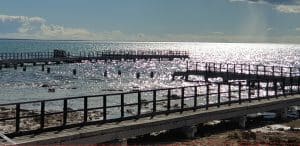 The Hamelin Pool Telegraph Station is a historic site, built in 1884 to connect the telegraph line between Perth and Roeburne. It played a vital role in the states communication system but also had a role in the 1969 moon landing!
The Hamelin Pool Telegraph Station is a historic site, built in 1884 to connect the telegraph line between Perth and Roeburne. It played a vital role in the states communication system but also had a role in the 1969 moon landing!
The nearby stromatolites are only one of two locations in the world that have them. The other location is in the Bahamas. The stromatolites and microbial mats are a diverse living ecosystem and represent also what it looked like eons ago. To allow visitors the experience in seeing this living structure, a boardwalk had been created over the top allowing you to be mesmerised by what nature can create. At the time of our visit, the boardwalk was still closed off to the public due to the severe damage the structure sustained in April 2021 when Cyclone Seroja went through the area. There are plans for the boardwalk to be replaced in the near future.
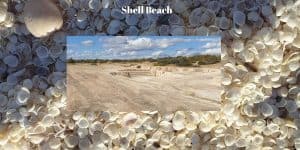 The final stop before reaching our accommodation was at the beautiful Shell Beach, 45 kms south of Deham within the Francois Peron National Park. As the name suggests, the beach is made up of trillions of shells, specifically the Fragum cockle. With the lack of predators in the hypersaline waters of this area, the Fragum cockle thrives thus creating this spectacular beach. We didn’t have time for a swim, though I would highly recommend it for the relaxation one experiences in being able to float peacefully in these calm and super salty waters. Take a walk down the beach and see where our early settlers used the coquina, the naturally compacted Fragum cockle, to create building blocks for their homes.
The final stop before reaching our accommodation was at the beautiful Shell Beach, 45 kms south of Deham within the Francois Peron National Park. As the name suggests, the beach is made up of trillions of shells, specifically the Fragum cockle. With the lack of predators in the hypersaline waters of this area, the Fragum cockle thrives thus creating this spectacular beach. We didn’t have time for a swim, though I would highly recommend it for the relaxation one experiences in being able to float peacefully in these calm and super salty waters. Take a walk down the beach and see where our early settlers used the coquina, the naturally compacted Fragum cockle, to create building blocks for their homes.
No visit to the Shark Bay peninsula is complete without an early morning drive to Monkey Mia to see the dolphins come into shore. Even they thought it was a tad cold as only one dolphin came in for a feed for the two sessions whilst I was at the beach! My highlight for the day, my bucket list item was to go out and see the dugongs. I was not disappointed. Even they don’t like the cold as I was told by one of the local Aboriginal tour operator who was also on board with his group. As it was early in the season we still managed to see a few dugongs, though I don’t know if it was the same mother and calf! To do such a tour, I highly recommend booking a tour on the Aristocat 2 by Perfect Nature Cruises, which enters the Dugong Exclusion Zone and operates in a sustainable manner thus minimising the impact on the native marine species of the area.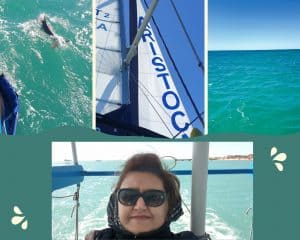
After lunch it was a quick stop at the Peron Homestead, a once working pastoral station. You can walk through the interpretive centre and shearing sheds and see what life was like living on a sheep station in the early 1900’s. On site is also an artesian bore, drilled in the early 1920’s to pump the water out to the livestocks watering points. Now it is used as a hot tub, a balmy 40 degrees Celsius.
We then moved on to Ocean Park, an award winning and ecofriendly aquarium. No two visits are alike in that any injured marine life is rehabilitated and then released back into its natural habitat.
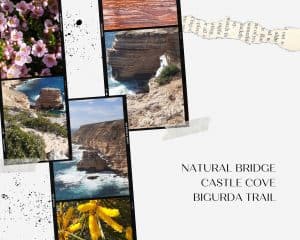
Saying goodbye to Deham was hard as we had lovely accommodation at the Denham Heritage Resort but also lovely winter weather albeit a bit windy.
Our destination for the day was in cyclone struck Kalbarri for a two night stay. Morning tea and leg stretch at the original Billabong Roadhouse before reaching Kalbarri in time for a late lunch.
Exploring Kalbarri cliffs was on the agenda in the afternoon by walking across the Natural Bridge (500mts return) and the Castle Cove (300mts return) and having well built look outs across the cliffs. There are some great locations to take those picture perfect shots. Walking along the Bigurda Trail you have to stop and take a closer look at the wildflowers of the area.
Looking at the cliff face along this coastline you can see why there were many shipwrecks before Terra Australia was truly discovered. Heading to south east Asia some of the Dutch ships who met their fate on these treacherous shorelines were the Zuytdorp, Zeewyck and Batavia.
Their story and some recovered artefacts can be seen at the WA Maritime Museum Geraldton.
The day ended as we watched the sun set over the ocean from the Meanarra Hill lookout whilst the full moon rose in the east behind us!
More hiking and exploring our outback this time at the Z Bend first thing in the morning. The early morning walk was well worth it as we not only missed the flies and increasing temperatures that we started to get on the way back to the car park. The faint coolness on the face as we peered over the railing in the gorge below as the sun rays danced along the cliff faces showing us the different hues of the orange rock. I could have stayed there all morning.
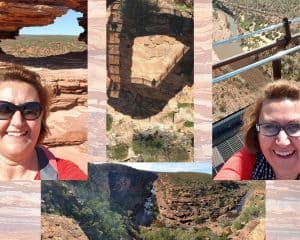 The day’s highlight, hard to pick really, is the new Skywalk. The first concepts were drawn in 2013, and then all coming to fruition with the official opening in June 2020. An innovative design that blends the structure into the natural landscape. From the carpark, it cannot be seen and if you are at the iconic Nature’s Window, the cantelever walkway looks like a rocky outcrop. A wonderful project that allows the visitor to observe the beauty of our Australian landscape. The walk down to Nature’s Window, you can get up close and see all the different coloured layers of the compacted Tumblagooda Sandstone. The walk is not complete without a photo in the natural window and the Murchison River passing through the gorge below in the background. It does get busy so be prepared to wait your turn as everyone has to take their many photos in different poses!
The day’s highlight, hard to pick really, is the new Skywalk. The first concepts were drawn in 2013, and then all coming to fruition with the official opening in June 2020. An innovative design that blends the structure into the natural landscape. From the carpark, it cannot be seen and if you are at the iconic Nature’s Window, the cantelever walkway looks like a rocky outcrop. A wonderful project that allows the visitor to observe the beauty of our Australian landscape. The walk down to Nature’s Window, you can get up close and see all the different coloured layers of the compacted Tumblagooda Sandstone. The walk is not complete without a photo in the natural window and the Murchison River passing through the gorge below in the background. It does get busy so be prepared to wait your turn as everyone has to take their many photos in different poses!
The afternoon drive includes a visit to the Lynton Heritage site in Port Gregory. It used to be the first convict depot north of Fremantle which was built to house the convicts who were primarily used as labour force for the Geraldine Mine – Site No 7. Built in 1853 and used until 1857 it housed up to 80 men who were usually ‘ticket of leave’ convicts.
You can’t go to Port Gregory (approximately 68kms south of Kalbarri) without having a photo opportunity stop at Hutt Lagoon, otherwise known as Pink Lake. We were lucky that most of the lagoon was very pink which is caused by the presence of the carotenoid producing algae, dunaliella salina, a source of beta carotene. It is the world’s largest source of microalgae production plant so the next time you pop in your mouth a supplement or put on makeup containing beta carotene, there is a good chance it may have come from the Hutt Lagoon! The best (and safest) place to park and walk down to the water’s edge is on Port Gregory Road rather than George Grey Drive.
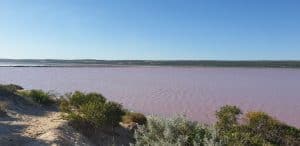
Did you know that across the road is the only mine in the world that mines, processes, refines and ships high industrial grade garnet?
It is used as an abrasive in blasting and the water jet cutting industries.
The day ended with a great fish and chip meal down on the foreshore back in Kalbarri and watching another sunset end on another educational day of discoveries.
Having lived in the North West of the state in the early part of my life, drives down to the city meant taking the straighest road possible and with the least amount of stops. So this meant driving all of North West Coastal Highway and stopping only at Billabong Roadhouse, Geraldton for lunch, Cataby Roadhouse for a leg stretch and maybe an icecream then city.
This trip we got to go down back roads like Ajana Road, an unsealed thankfully recently graded road which took us through the rural town of Ajana. Now with only the odd house remaining, it was actually the terminus of an extension of the first government railway in Western Australia. It assisted with the transportation of lead being mined in the area as well as agriculture. After going for another bush walk for more wildflower identification, our morning tea was in the small town of Northampton just 53kms away. I had never stopped in the town before but had discovered two things that I did not know about: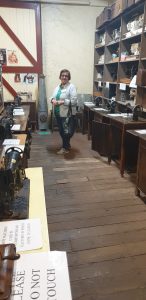
If you wish to go on the 6 day Coral Coast tour with Casey Tours, there are 2 more departures left for this year:
Prices start from $2040 per person twin share, seniors rate. There is a single supplement of $400.
To partake in a wildflower focussed tour with a botanical guide with Casey Tours, there are various 4 day trips in September and October. Some already have waitlists so you need to get in quick.
If however you wish to do a self drive and still explore Kalbarri with a local guide, I have that option also available with prices starting from $49 and able to take up to 13 passengers.
For bookings on the Aristocat2 in Monkey Mia, please contact me to organise this for you.
To book your next trip or ask me for more information, you can call me on 0415 234 685 during office hours or email me [email protected]